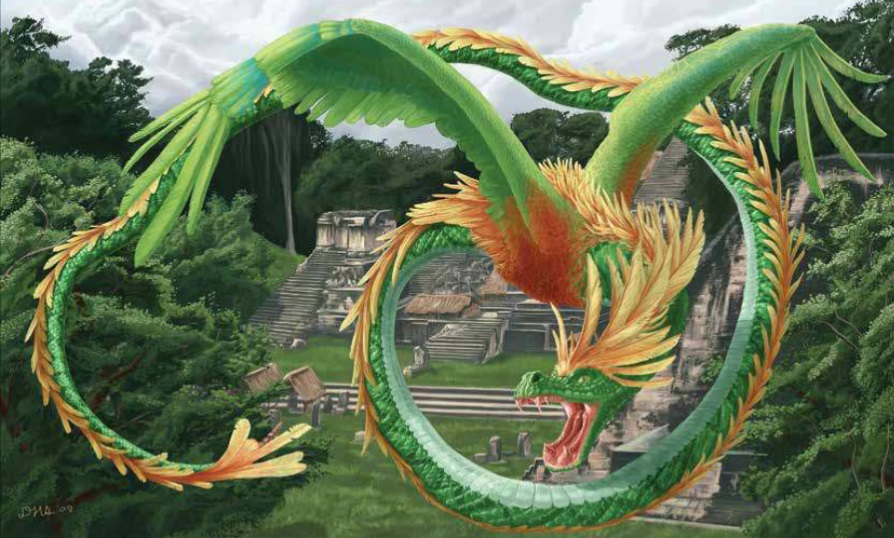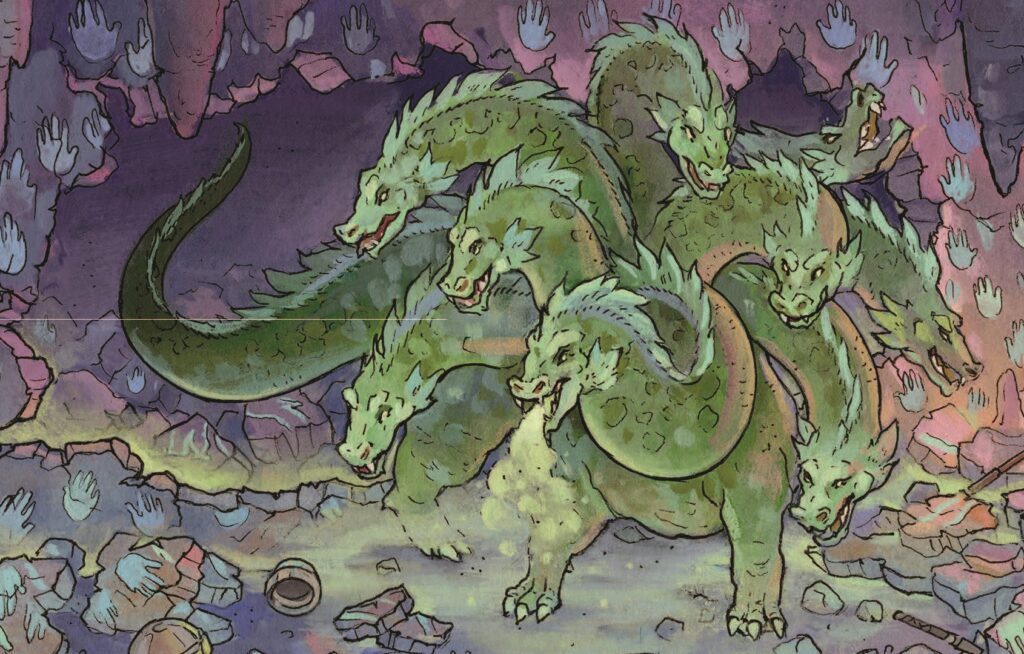Lunar New Year is here. The Year of the Dragon officially begins on February 10! As millions of people worldwide celebrate this milestone holiday, we’re looking into the amazing significance of dragons in cultures from around the world.
Why exactly are dragons so prevalent in folklore from seemingly disparate civilizations? Well, first of all, you could argue that the definition of ‘dragon’ is pretty hazy. Some dragons have four legs, some have two legs, and some have no legs at all. Some are long and skinny and others are powerfully built. And some fly, some swim, and some do both! While some dragons seem to represent forces of evil or greed that must be overcome, many others are largely benevolent, bestowing wisdom or good fortune on those who deserve it. Why are these all called ‘dragons?’ You could argue that it’s just an English name applied to concepts as different as apples and oranges. But then there’s another possible explanation: what if dragons come from a common source?


Where do dragons come from?
Many scholars believe that tales of dragons grew from creatures that we call by a different name today: dinosaurs. The word ‘dinosaur’ was coined in 1841, but that doesn’t mean nobody ever saw evidence of the creatures before the 19th century. People who unearthed massive ancient fossils must have come to a similar conclusion: “These bones belonged to a giant reptile. And if their bones are still around, there might still be some alive out there.”
Alternatively, some researchers, like anthropologist Dr. David E. Jones , think there’s an evolutionary basis to dragon myths. Growing out of the primal fear and respect that humans feel for predator species, Jones believes dragons combine elements of different powerful predators. Dragons possess traits of crocodiles, big cats, birds of prey, snakes, even elephants and whales– all creatures that humans fear. They even share some traits with natural disasters, like earthquakes or volcanoes.
Finally, some people believe dragon stories have been passed around from culture to culture, changing to adapt to local standards. Early civilizations may have been more connected than we realize. With all that said, here are just a few different representations of dragons from different cultures!


Chinese Dragons
Dragons play a huge role in Chinese culture, with stories dating back over 5,000 years. Many Chinese traditions, including the dragon dance, dragon kites, and dragon boat races, place these mysterious creatures front and center. A Chinese dragon, or loong, is typically more like a sea serpent– a long, skinny, creature with an affinity for water– but can also fly. Dragons are seen as protectors of the land who can bring rain and a good harvest. Because of that, the Year of the Dragon is considered the most auspicious year in the zodiac.
“The Dragon’s Pearl” is one of the oldest and most famous Chinese folktales featuring a dragon. In it, a corrupt, greedy emperor rules over a starving kingdom. When a little boy discovers a patch of grass that keeps growing back overnight, he digs beneath it and finds a huge pearl. When he places the pearl in a sack of rice, the rice multiplies until it overflows. The pearl helps him and his mother become wealthy, sharing their good fortune with friends and neighbors. But naturally, the wicked emperor finds out and comes to claim the pearl for himself. When the boy swallows the pearl, hoping to keep it from the emperor, he transforms into a dragon, now a permanent guardian of the land.


British Dragons
Did you know that the Welsh flag features a big red dragon? The symbol is traditionally associated with the Welsh King Cadwaladr, who reigned over 1,300 years ago, though we can’t find any proof that he actually used it in his lifetime. Later, an Arthurian legend tells of Merlin’s vision of red and white dragons who wake from a long slumber and fight one another. The red dragon, initially seeming the weaker, finally drives the white dragon away. In the legend, the white dragon represents the Saxons and the red dragon? The Britons.
In English legends, however, dragons often get a pretty bad rap. They’re typically greedy, gluttonous, nasty creatures who blight the country rather than protecting it. The story of Saint George and the Dragon is one of the most popular early Christian myths. In it, a covetous dragon demands tributes from villagers, first livestock and jewels, then when those run out, people. But when the dragon wants to take a princess as a tribute, England’s patron saint, George comes to the rescue and slays the dragon. In this patriotic story, the dragon can symbolize a Roman emperor, England’s enemies in general, or even Satan. (Fun fact: there’s a children’s book of this legend illustrated by CRICKET Magazine’s first art director, Trina Schart Hyman!)


Norse/Germanic Dragons
There’s some shared history and culture between England, Germany, Nordic countries, and other parts of Europe, so you’ll see some common themes among their tales. One dragon who straddles German and English culture is Beowulf’s foe. A fire-breathing dragon who terrorizes Geatland, he turns out to have another scary power: venom. Although Beowulf and one of his noblemen succeed in slaying the dragon, Beowulf slowly dies from the dragon’s venomous bite. Norse and Germanic dragons tend to be snakelike (sometimes called wyrms) and preside over massive hordes of treasure, and these tales helped inspire Smaug from J.R.R. Tolkien’s The Hobbit.
The most famous dragon in Norse and Germanic legend is named Fáfnir. This bad boy wasn’t always a dragon but transformed into one. He is snakelike and doesn’t fly, but he DOES hoard massive amounts treasure. The hero, Sigurd or Sigfried, can only defeat him by finding his weak spot: hiding beneath him and stabbing from below into his soft underbelly or his heart. It’s interesting how a story like this and the Chinese story of the Dragon’s Pearl both feature themes of greed and hoarding– but in one, the dragon is the villain and in the other, he’s the hero.


Mesoamerican Dragons
We know dragon myths are popular in Asia and Europe, but what about the Americas? Depending on how you see things, the most powerful, prominent deity in Aztec and Maya culture might just be a dragon. Quetzalcóatl’s name means “feathered serpent,” and that’s the form he typically took. That’s also a pretty apt description of what we know today about dinosaurs– or, by extension, dragons.
As a powerful creator deity, he was the god of countless different things throughout Aztec and Maya cultures: the Sun, the wind, learning and reading, the morning and evening star, agriculture, the calendar, death and resurrection and even more. In one legend, Quetzalcóatl creates humans out of bones he stole from the underworld. Interestingly enough, humans just might have returned the favor. In 1971, fossilized remains of a massive pterosaur were found in Big Bend National Park. What did scientists name this extraordinary creature? Quetzalcoatlus.


Aboriginal Australian Dragons
Many Aboriginal Australian gods appear as serpents, and some of the most famous of all are called Rainbow Serpents. These go by many different names in different languages and cultures and feature in countless different stories. What do they have in common? They’re huge, they’re powerful ancestral beings, they, like Chinese dragons, are associated with water, and they have rainbow colored or iridescent scales! Whether they’re helpful or destructive seems to vary depending on the tale… or the serpent’s mood.
One type of legendary serpent, the Wagyl or Waugal from the Noongar culture, was said to have created the local terrain by slithering across the land with its large, powerful body. The Wagyl left hills, valleys, and shaped the flow of rivers. It, like Quetzalcóatl, is often described as a creator figure who gives life to humans. That doesn’t mean it can’t also be dangerous. It’s common for Noongar people to avoid swimming anywhere the water seems murky and disturbed, because that means a Wagyl is swimming there– you wouldn’t want to disturb it, too.


Ancient Greek Dragons
Where does the word ‘dragon’ actually come from? It derives from an Ancient Greek word: drakōn. These beasts typically looked like giant serpents, though some had multiple heads (more on that later). Some of these dragons, like the one Beowulf fought, had deadly venom, and some of them could fly, but most served as intimidating guardians to some kind of powerful resource.
One notable dragon guarded the famous Golden Fleece. This dragon never slept, and its teeth could transform into soldiers when they fell to the ground. Definitely a menacing foe to face. Depending on which version of the tale you read, the hero Jason either slew the dragon or the witch Medea put it to sleep for him so that he could steal its prized Fleece. Another mythological dragon was a hundred-headed serpent named Ladon who guarded a tree full of golden apples that Heracles had to retrieve as one of his twelve labors. According to some stories, this dragon was immortalized as the constellation Draco. This makes some sense– after all, its head is right under Hercules’ foot!
Do you have a favorite dragon in folklore or pop culture? We’d love to hear about it!
Celebrate the Year of the Dragon by trying a Chinese language lesson! We offer live online Mandarin Chinese classes for kids and adults, whether you prefer individual or group classes. Get started today!



